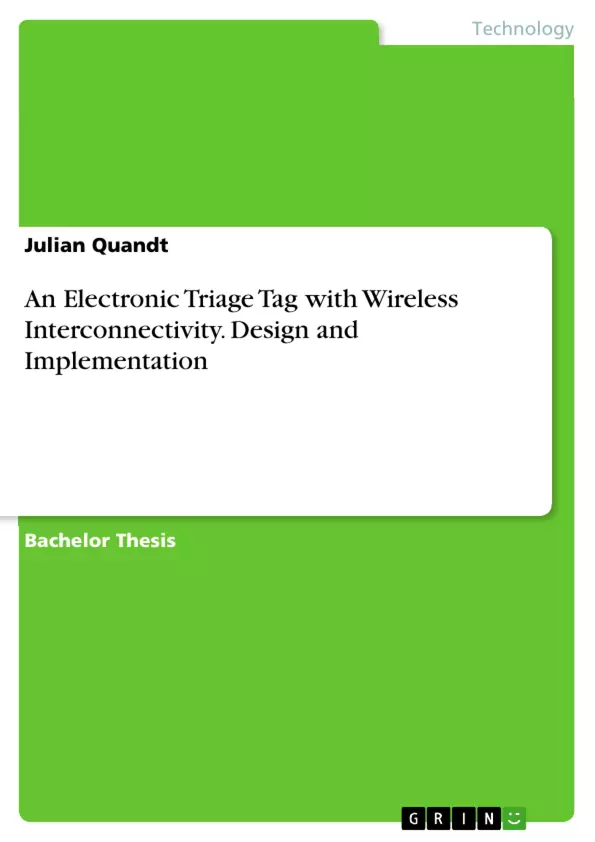In this thesis an electronic triage tag with wireless interconnectivity is developed, implemented and tested. The tag submits triage information to the incident command center over a wireless mesh network which is built up by the tags themselves. Furthermore the tag is wirelessly interfaceable with vital value sensors to allow live monitoring of patients. The developed device works autonomously, without any user intervention and is attached to colored bracelets which are already used for triage. There is no need to change the triager’s work flow. The electronic triage tag is a time-efficient extension for existing triage tools to aid rescue forces in accelerated treatment and evacuation of victims.
Mass Casualty Incidents (MCI) overwhelm medical resources and require the treatment of a large amount of patients within a very short time. Triage is a process used in MCIs to assign scarce medical resources to victims so that as many as possible can survive. Currently, the triage process is carried out with the help of a Paper Based Patient Tag with a unique ID, signaling the victim’s treatment priority by its color (red, green, yellow or black). Paper-based triage strives for a fast and accurate treatment of victims, but it has problems with regard to the speed and accuracy of transmitting triage information. Live monitoring of victims’ vital values is not possible because of the paper-based process and the lack of medical personnel. An electronic approach promises a faster situation overview and, thus, faster treatment of victims. However, the introduction of new systems must be done in a sensible way, so that the triager’s process and workflow is not modified.
Inhaltsverzeichnis (Table of Contents)
- Abstract
- Acknowledgements
- 1. Introduction
- 1.1. Motivation
- 1.2. Scope
- 1.3. Outline
- 2. Background
- 2.1. Triage
- 2.1.1. The START Triage Method
- 2.1.2. Other Mass Casualty Triage Systems
- 2.1.3. Triage Tags
- 2.2. Issues With Current Triage Tags
- 2.3. Related Work
- 2.3.1. SOGRO MANV 500
- 2.3.2. AID-N
- 2.3.3. WIISARD
- 2.3.4. eTriage
- 2.3.5. More Related Projects
- 2.4. Analysis
- 2.1. Triage
- 3. Requirements for an Electronic Triage Tag
- 4. The eTriage Concept
- 5. Hardware Development
- 5.1. Selection of Communication Standard
- 5.2. The eTriage Tag
- 5.2.1. Selection of Soft- and Hardware Platform
- 5.2.2. Selection of Hardware Components
- 5.2.3. Communication Interfaces
- 5.2.4. PCB Design
- 5.2.5. Assembling the PCB
- 5.2.6. Case
- 5.2.7. Assembling the eTriage Tag
- 5.3. The eTriage Gateway
- 6. Software Development
- 6.1. Developing with Lightweight Mesh
- 6.1.1. Typical Application Structure
- 6.1.2. Basic Network Configuration
- 6.1.3. Data Transmission
- 6.1.4. Data Reception
- 6.1.5. Software Timer
- 6.2. The eTriage Tag Firmware
- 6.2.1. Application Task Handler
- 6.2.2. AD Conversion of Temperature Sensor Voltage
- 6.2.3. GPS Interface
- 6.2.4. Micro SD SPI Protocol
- 6.2.5. Address Initialization and Administration
- 6.2.6. Communication Protocol
- 6.2.7. Software Timer
- 6.2.8. LED Indicator
- 6.1. Developing with Lightweight Mesh
- 7. Testing
- 7.1. Hardware Functionality Test
- 7.1.1. Assembled Hardware Components
- 7.1.2. Operating Time
- 7.1.3. Range Test
- 7.2. Software Test
- 7.2.1. Module Test
- 7.2.2. System Test
- 7.1. Hardware Functionality Test
- 8. Conclusion and Future Work
- 8.1. Conclusion
- 8.2. Future Work
- A. Schematics and Layout
- B. Software
- B.1. AppMessage_t Structure
- B.2. Fuse Bit Settings
- B.3. Introduction to Lightweight Mesh
- B.4. Data Transmission Options and Status Codes
- B.5. Data Reception Options and Status Codes
Zielsetzung und Themenschwerpunkte (Objectives and Key Themes)
This bachelor thesis explores the design and implementation of an electronic triage tag with wireless interconnectivity, aiming to improve efficiency and accuracy in mass casualty incidents. The project addresses the shortcomings of traditional paper-based triage tags and investigates the potential of utilizing wireless technologies for real-time patient data collection and communication.
- Development of a robust and reliable electronic triage tag.
- Integration of wireless communication technologies for efficient data transfer.
- Optimization of hardware and software components for optimal performance and user experience.
- Assessment of the feasibility and advantages of using electronic triage tags in real-world scenarios.
- Exploration of potential applications and future directions for the eTriage system.
Zusammenfassung der Kapitel (Chapter Summaries)
- Chapter 1: Introduction provides the motivation and background for developing an electronic triage tag. It highlights the limitations of existing triage methods and outlines the scope and objectives of the thesis.
- Chapter 2: Background delves into the concept of triage and examines various triage methods, including the START method and other mass casualty triage systems. It also analyzes the existing issues with traditional triage tags and reviews related work on electronic triage systems.
- Chapter 3: Requirements for an Electronic Triage Tag defines the essential features and functionality that an electronic triage tag should possess to effectively support triage operations.
- Chapter 4: The eTriage Concept presents the overall design concept of the eTriage system, outlining the components and their interactions.
- Chapter 5: Hardware Development details the hardware design of the eTriage tag, covering the selection of communication standards, components, and the development of the PCB design.
- Chapter 6: Software Development focuses on the software development aspects of the eTriage system, including the development of the eTriage tag firmware and the integration of Lightweight Mesh for wireless communication.
- Chapter 7: Testing describes the comprehensive testing procedures conducted to evaluate the hardware and software functionality of the eTriage system.
Schlüsselwörter (Keywords)
This project focuses on the design and implementation of an electronic triage tag with wireless interconnectivity, incorporating key concepts like triage, mass casualty incidents, wireless communication, hardware development, software development, Lightweight Mesh, and testing.
- Citation du texte
- Julian Quandt (Auteur), 2015, An Electronic Triage Tag with Wireless Interconnectivity. Design and Implementation, Munich, GRIN Verlag, https://www.grin.com/document/1305586



